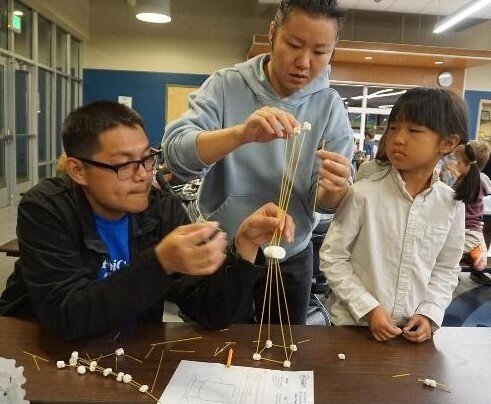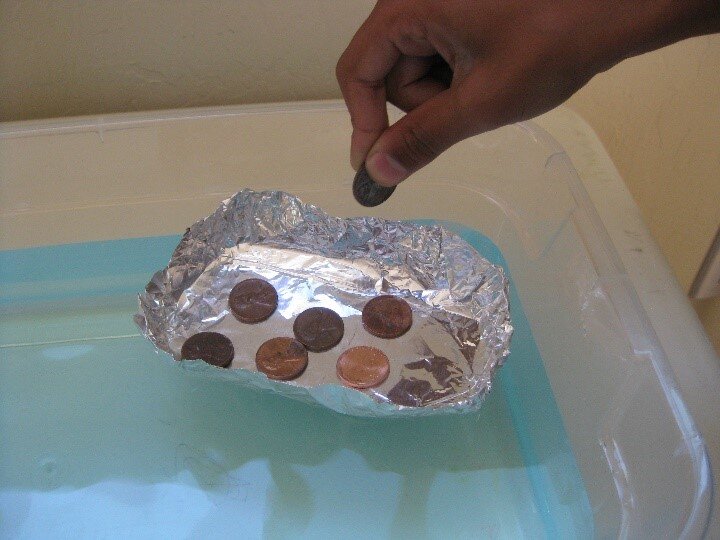Think Like an Engineer Webinar - Part 1 & 2
Discipline: Engineering
Age Range: 7+
Estimated Time: 60 minutes for each webinar
What You Need: Part 1 - 2 pieces of paper; a pen or pencil; two cups of the same size; 15-20 pennies (preferred) or other small objects (paperclips, almonds, beads, etc.)
Part 2 - 8 pieces of paper; tape; two plastic bins or containers of the same height; small objects for weights (blocks, small plastic building bricks, coins, etc.); a pen or pencil
Engineers are problem solvers! In this interactive webinar, learn how engineers use math, science, and a special process to design solutions to real-world problems!
Each webinar will take you through the engineering design process in order to solve a problem. Listen to a story and use hands-on science to solve how to cross the river.
Think Like an Engineer Part 1 - 60 Minutes
Think Like an Engineer Part 2 - 60 Minutes
Tallest Tower Challenge Using Spaghetti
Discipline: Engineering
Age Range: 5+ (with adult supervision)
Estimated Time: 5-20 minutes
What You Need: Uncooked spaghetti; marshmallows or gumdrops; and a tape measure (optional)
Instructions: Your goal is to build a freestanding tower out of spaghetti and marshmallows. Your tower cannot be connected to anything else, and cannot lean on anything for support.
What shapes can you create with your spaghetti and marshmallows?
What shapes do you think will create the strongest tower?
Try different designs to see what works best. Once your tower is built and stable you can measure it to see how tall it is. Think about how you can improve your tower and try building it again.
Challenge Options:
Set a timer to see if you can build your tower in a certain amount of time.
Can you build a tower that’s at least 15 inches tall?
Have fun and remember to keep trying!
Aluminum Foil Boat Challenge
Discipline: Physical Science
Age Range: 5-12
Estimated Time: 10 minutes
What you need: Aluminum foil (sheets should be approximately 10 in x 10 in), weights (can use marbles, pennies, glass gems, rocks, etc.), and a bucket or sink filled with water
Instructions:
Use one sheet of aluminum foil to create a boat that can hold as much weight as possible.
You may not use anything to build your boat other than your one sheet of aluminum foil.
Once your boat is complete, put it in a bucket or sink filled with water and see how much weight it can hold. Continue adding weight until your boat starts to take on water or sink. You can count how weights your boat can hold, or put it on a scale to weigh how it could hold before your boat sank or took on water.
Once you test your boat, try to improve it. What worked well the first time? What can you improve? Design another boat and repeat steps 1 through 3.
https://science4superheroes.files.wordpress.com/2014/10/img_2228.jpg
Hole in One Challenge
Discipline: Engineering
Age Range: 7+
Estimated Time: 5 minutes
What you need: Index cards and scissors
Instructions:
Use the scissors to cut an opening in an index large enough to fit your head through. In order for it be considered right, the cut index card needs to have two closed ends.
Once you succeed at the first challenge, the second challenge is to cut an opening large to fit an entire family member from head to toe.
Keep in mind there is more than one right answer.
Hint: If this one stumps you, here’s a YouTube video on one way to accomplish this challenge.
Learn Height and Fathom
Discipline: Mathematics and Measurement; Proportion
Age Range: 5+ (with adult supervision)
Estimated Time: 10 minutes
What you need: Measuring tape, a pencil and paper to write down your findings (If you don’t have one, you can use a string and a ruler or other alternatives described below.)
Instructions: A fathom is a measurement from fingertip to fingertip for a person when standing straight up, with both arms spread out to the side. For many people, their height (from the bottom of the foot to the top of the head) and their fathom are the same! Follow these steps below to see how your height and fathom compare.
Take off your shoes and ask a family member or friend to measure your height while standing up straight. If you don’t have someone to help, just lay on the floor with your feet flat against a wall. Mark where the top of your head is with a small object such as a coin or a pencil. Write down your height on a piece of paper.
Hold your arms out straight to your sides. Ask a family member or friend to measure your fathom (from the ends of your fingertips on one hand to the other). If you don’t have someone to help, lay down with your arms spread wide, brushing the fingertips on one hand up against the wall. Use a small object to mark the ends of your fingertips (on your hand not touching the wall). Write down your measurement for fathom.
Are your height and fathom the same or different? Either result is normal! If they are different, subtract the smaller number from the larger one to find the difference! Write down your answer.
As we grow, our body measurements and ratios change. Adults are more likely to have matching and height and fathom measurements because they are finished growing. Try measuring an adult in your house and see how their results compare to yours!
Wind Cars
Discipline: Engineering, Physical Science
Age Range: 7-12
Estimated Time: 20 minutes
What you need: Notecards or paper, four-to-five straws, four lifesavers, one meter of tape
Note: Supplies can be substituted or exchanged for materials you have at home. For example, notecards can be swapped for cardboard, straws can be swapped for pencils, and lifesavers can be swapped for anything that is round or moves!
Instructions:
You will use the materials you have been given (or gathered) to create a car that is powered by the wind (your breath).
Your only rule is that your wheels must move!
Once your car is complete place it on the floor or on a tabletop, blow a gust of wind, and see how it flies! (Additional tests: see how many breaths it takes to move across the floor, or measure the distance your car traveled in one breath.
Once you test your car, try to improve it! What worked well the first time? What can you improve? Design another car and repeat steps 1-3!
Resources: https://www.teachengineering.org/activities/view/cub_sailcars_activity1 http://www.lynnmiskell.com/puff-car/
Other design option.
Other design option.

















